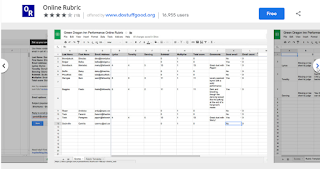I routinely use Google Drive for productivity tools including planning and organization. This video shows
the layout of my Google Drive folders so I can find what I need when I need it.
The drive is sorted by grade level, and I can click through to long range plans, daily lesson plans, or
performance details. The use of cloud-based technology has simplified my planning process since I carry any document I need
in my phone.
the layout of my Google Drive folders so I can find what I need when I need it.
The drive is sorted by grade level, and I can click through to long range plans, daily lesson plans, or
performance details. The use of cloud-based technology has simplified my planning process since I carry any document I need
in my phone.
Since I can easily access the files I need to plan instruction, I am confident I have an easier time creating
more purposeful and sequential lesson plans. These plans will be even more purposeful and sequential
as I continue to grow in my use of technology for assessment.
more purposeful and sequential lesson plans. These plans will be even more purposeful and sequential
as I continue to grow in my use of technology for assessment.
Assessments are a crucial part of the instruction process since they tell the teacher what the student
needs in order to succeed. In the textbook, Music Learning Today by Dr. William Bauer, the other states:
needs in order to succeed. In the textbook, Music Learning Today by Dr. William Bauer, the other states:
(p. 132)
Through the use of both valid and reliable assessments (p. 133), teachers and students can get a picture
of the students progress as the teacher provides feedback that is corrective, timely, and specific (p. 133).
of the students progress as the teacher provides feedback that is corrective, timely, and specific (p. 133).
One of the most valuable forms of assessment is authentic, or performance-based. In this type of
assessment students are asked to apply their knowledge and skills in a real-world scenario, and present
their work to an audience.
assessment students are asked to apply their knowledge and skills in a real-world scenario, and present
their work to an audience.
I strive to include authentic assessments by creating informances at my school. In an informance,
students show their parents what they are learning in music class, and demonstrate some of our favorite
classroom games and songs. The music in this informance is entirely student-driven. That is, it is either
arranged by students, composed by students, or includes an improvisation element created by the
students. Before the program students teach the audience about the rhythms and melodic elements they
have learned, and give their parents something to listen for in each piece. This type of assessment not
only allows me to see how students process and create from their musical knowledge, but it also shows
parents and administrators the critical thinking and innovative tasks students perform in a typical
elementary music classroom.
students show their parents what they are learning in music class, and demonstrate some of our favorite
classroom games and songs. The music in this informance is entirely student-driven. That is, it is either
arranged by students, composed by students, or includes an improvisation element created by the
students. Before the program students teach the audience about the rhythms and melodic elements they
have learned, and give their parents something to listen for in each piece. This type of assessment not
only allows me to see how students process and create from their musical knowledge, but it also shows
parents and administrators the critical thinking and innovative tasks students perform in a typical
elementary music classroom.
Though I strive to valid and reliable assessments for my students, I found numerous areas of growth as
I studied this module. I specifically found the book’s companion website to be incredibly useful in
finding technology resources for assessment. For example, OrangeSlice and Online Rubric are Google
extensions that I see myself using on a weekly or daily basis. I have installed both programs and look
forward to using them this week.
I studied this module. I specifically found the book’s companion website to be incredibly useful in
finding technology resources for assessment. For example, OrangeSlice and Online Rubric are Google
extensions that I see myself using on a weekly or daily basis. I have installed both programs and look
forward to using them this week.
I am confident that the further use of technology resources from this module will improve my students’
learning experiences through purposeful and engaging assessment.
learning experiences through purposeful and engaging assessment.



Comments
Post a Comment